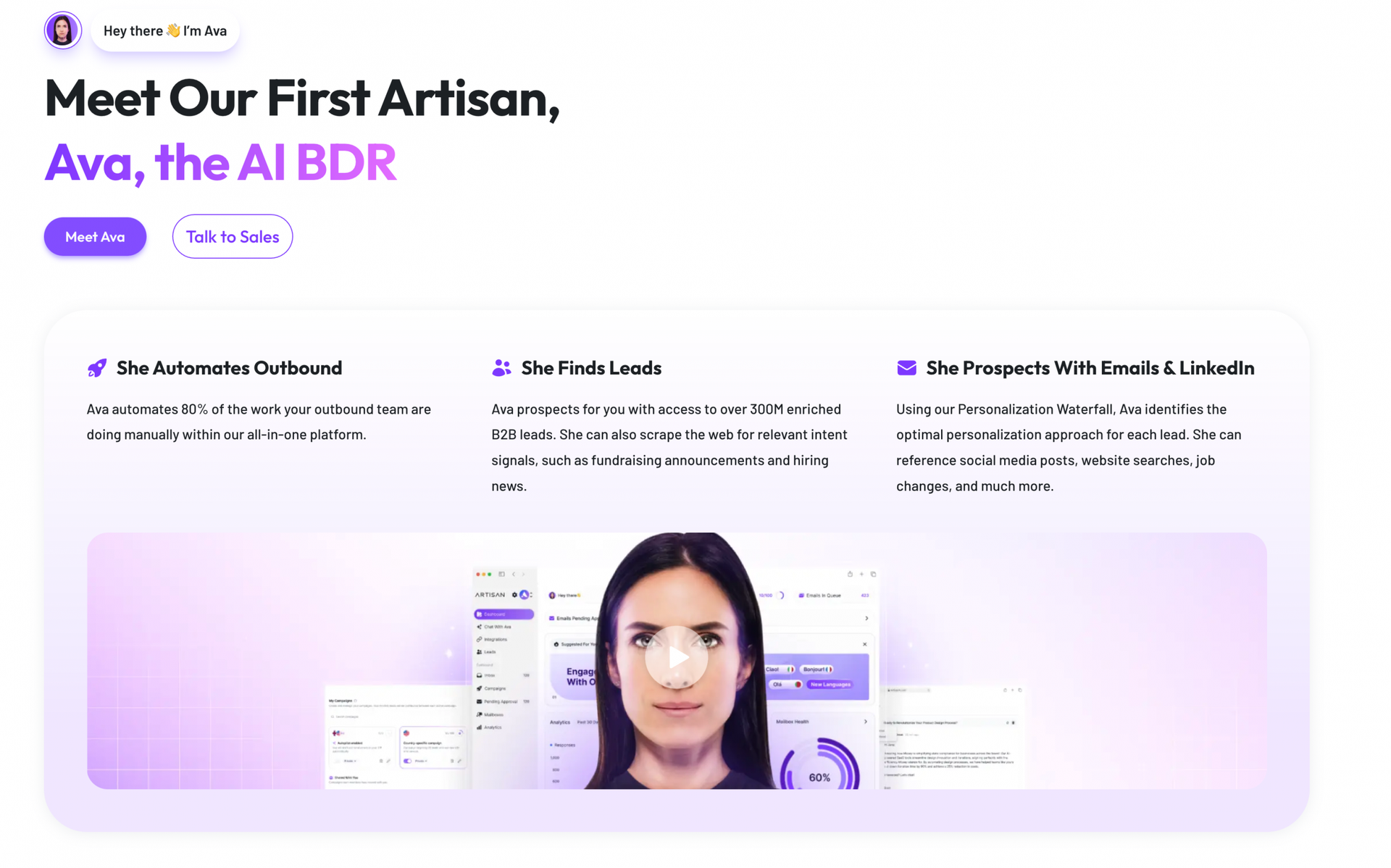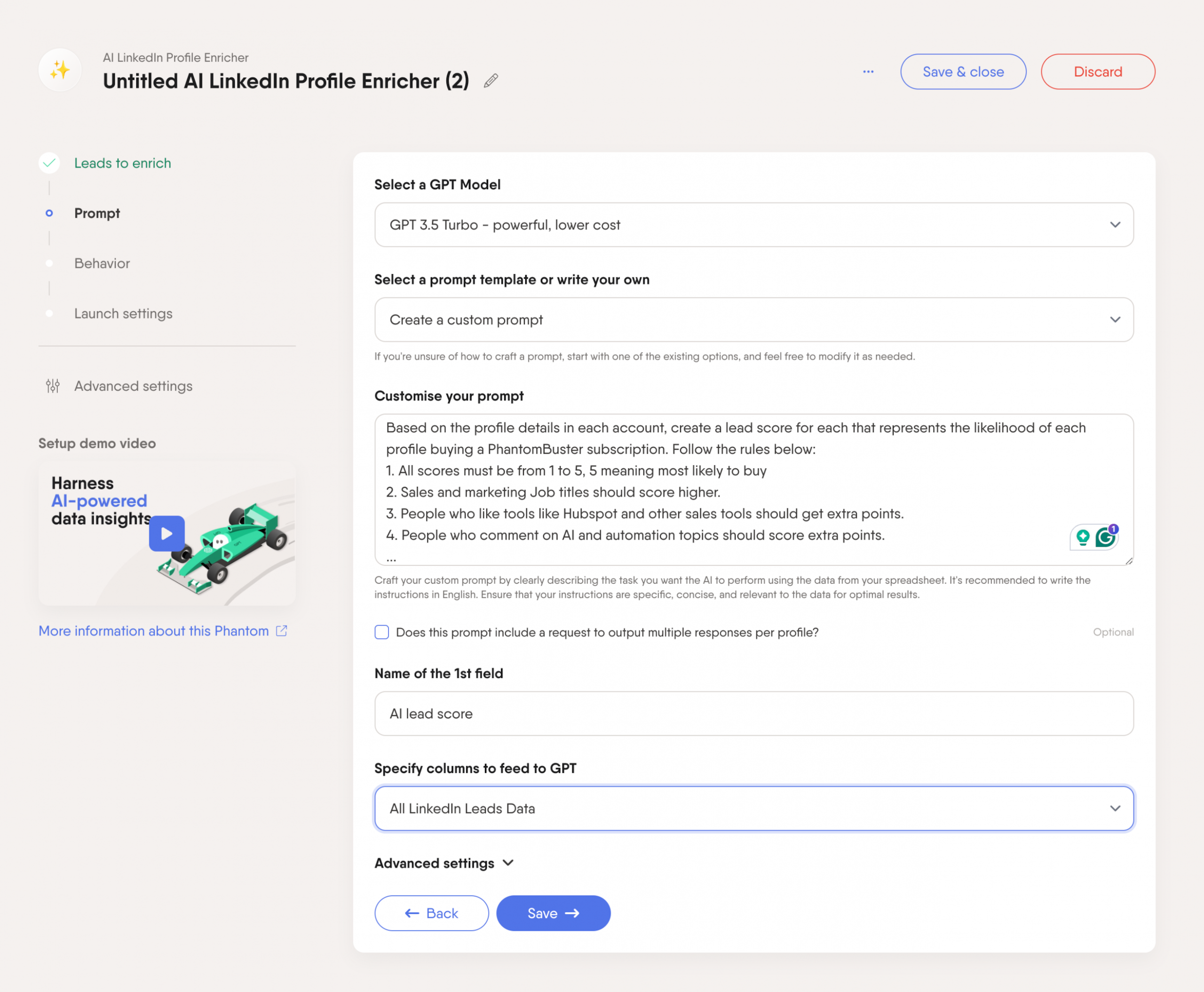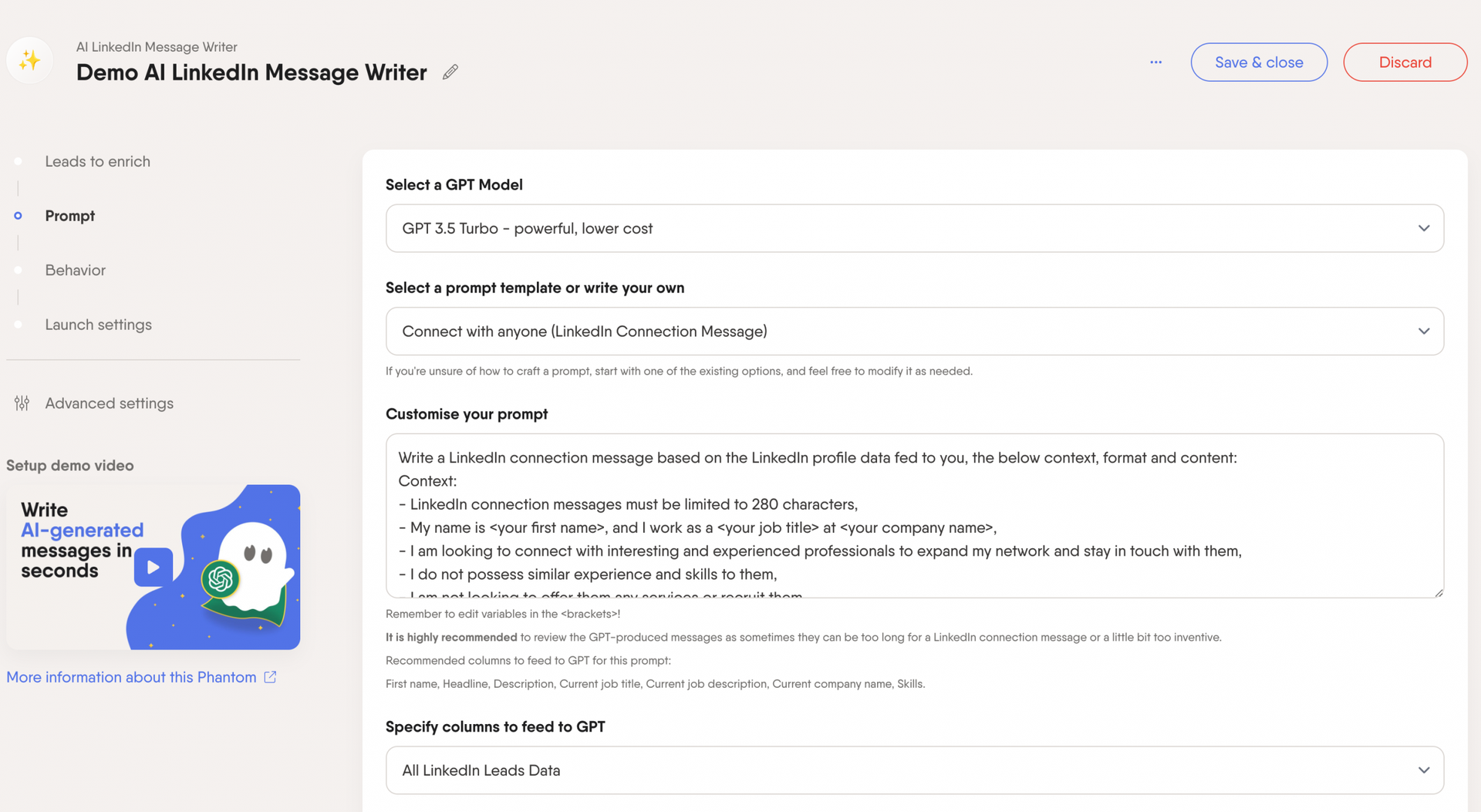Outbound prospecting is a proactive sales approach in which reps contact potential customers rather than waiting for them to come in through inbound channels.
This guide breaks down the key tactics and best practices to help your team generate leads effectively.
AI highlights
- Outbound prospecting is the process of reaching out to potential customers to generate leads.
- Outbound prospecting best practices include using intent data, personalizing outreach with AI, leveraging social selling, and running multi-channel outreach to improve response rates.
- Here’s a recap on how to structure your approach, along with the best tools:
| Tactic | Description | Best Tool |
| Define your ICP | Identify your ideal customers based on firmographics, demographics, and behavioral traits. | M1-Project’s AI |
| Build a list of leads | Gather potential contacts from databases, social platforms, and real-time data extraction. | LinkedIn Post Commenter and Liker Scraper |
| Enrich your leads list | Add missing details like email addresses, job titles, and company insights. | Artisan |
| Qualify your leads | Score leads based on engagement, job title, and likelihood to convert. | AI LinkedIn Profile Enricher |
| Leverage personalized outreach | Craft tailored messages based on lead data and interaction history. | AI LinkedIn Message Writer |
| Follow up with your leads | Automate follow-up sequences to stay top-of-mind with prospects. | AiSDR |
How to build an outbound prospecting strategy
Each step of your outbound prospecting strategy—from identifying your ICP to following up—plays a role in improving results.
Here’s how to structure your approach to attract prospects and generate revenue easily.
1. Define your Ideal Customer Profile (ICP)
A well-defined Ideal Customer Profile (ICP) is the foundation of any successful outbound prospecting strategy. Without a clear understanding of your best-fit customers, you risk wasting time on leads that will never convert.
A strong ICP includes details like:
✅ Industry and company size: What sectors do they operate in? How big are they?
✅ Job titles and decision-makers: Who influences the buying decision?
✅ Pain points and challenges: What problems are they trying to solve?
✅ Buying signals and behavior: How do they evaluate and purchase solutions?
To create an accurate ICP without guesswork, you can use AI sales tools. For example, M1-Project’s AI lets you build your ICP in minutes.

Simply input basic details about your target market, and its ICP Generator will analyze market trends, competitor data, and customer insights to generate a detailed, data-driven profile.
2. Build a list of potential customers
Once you’ve defined your ICP, it’s time to gather a high-quality lead list.
While traditional databases work, real-time data extraction tools ensure fresher and more accurate information.
We recommend using PhantomBuster’s LinkedIn Post Commenter and Liker Scraper to identify engaged leads actively interacting with posts related to your product or service industry.
These prospects show intent and are more likely to convert.
💡 Tip: Start by scraping engagement from a LinkedIn post shared by a competitor or industry leader. If someone is commenting on a post about solutions similar to yours, they might already be in buying mode, so they’re prime targets.
3. Enrich your leads with key contact details
To make your outreach effective, you need email addresses, phone numbers, and additional insights like job title changes or recent activity. The more details you have, the better you can personalize your approach.
Look for real-time data enrichment to keep your records accurate—outdated information leads to lost sales opportunities.
AI tools like Artisan or Clearbit can:
- Auto-fetch verified contact details.
- Provide real-time updates on job changes.
- Score leads based on engagement data.

This helps you better target high-value prospects that you can quickly convert into paying customers.
4. Identify promising contacts with lead qualification
Not all leads are worth pursuing. Lead qualification helps you focus on the right prospects instead of wasting time on contacts who won’t convert.
To qualify leads effectively, we recommend focusing on three key factors:
✅ Company fit: Does their company match your ICP?
✅ Job role relevance: Does this person have buying power?
✅ Engagement level: Have they interacted with your brand or competitors?
The best way to do it is to automate your lead-qualification process with AI.
With PhantomBuster’s AI LinkedIn Profile Enricher, you can analyze LinkedIn profiles and assign a lead score based on key data points like job title, seniority, and engagement history.

💡 Tip: When setting up your lead-qualification automation, customize your scoring criteria to match your ICP. For example, assign higher scores to decision-makers and those who have engaged with relevant LinkedIn posts.
5. Send personalized messages to your potential buyers
Starting real conversations with prospects is what matters in cold outreach. To break through the noise, your messages must be highly relevant and feel like they were written just for them.
That’s when AI steps in to help you adapt messages based on key details and auto-generate outreach sequences that feel natural and human, not robotic.
With PhantomBuster’s AI LinkedIn Message Writer automation, you can instantly craft personalized messages tailored to each prospect. Instead of spending hours tweaking outreach, you can send messages that feel custom-made in seconds.

💡 Tip: Check out our AI Prompt Guide for tips on crafting sales messages that get replies.
6. Set up timely follow-up
Reaching out once isn’t enough. Most prospects need multiple touchpoints before they respond, which makes consistent follow-ups essential.
Instead of manually tracking every conversation, you can automate your outbound process to stay on top of your pipeline and prevent leads from slipping away.
AI sales assistant tools like AiSDR help you:
- Automate multi-step follow-up cadences so every prospect gets the right message at the right time.
- Adjust message tone based on prospect behavior, making your outreach more natural.
- Keep your pipeline organized by ensuring no lead is forgotten.

💡 Tip: Space out your follow-ups strategically while gradually increasing urgency. For example, you can try this sequence:
– After 3 days: Send a friendly check-in to stay on their radar.
– After 7 days: Follow up with a key benefit to reinforce value.
– After 10 days: Send a final message with a sense of urgency or FOMO to encourage a response.
Best practices for your outbound sales strategy
A thoughtful approach helps sales reps stand out, get better responses, and build stronger relationships.
Here are a few best practices to improve your outbound prospecting strategy.
Leverage intent data to find quality leads
Outbound prospecting works best when you reach out to prospects at the right time—when they need your solution.
That’s where intent data comes in. Instead of blindly messaging cold leads, you can focus on those already showing buying signals, like job changes, funding rounds, or leadership shifts.
In this LinkedIn post, Alexander Estner explains how tracking trigger events—such as new job postings, revenue growth, or M&A activity—can triple the success of outbound prospecting.

Instead of traditional cold outreach, you can use these insights to turn it into “semi-warm” outreach, making it easier to start meaningful conversations.
Use AI to personalize your outreach efforts
Personalization is a must if you want your outreach to get responses. But let’s be real—doing it manually at scale isn’t realistic.
AI makes it easier by pulling in data like job titles, interests, and past interactions so you can send messages that feel relevant without spending hours researching each lead.
Instead of guessing what matters to them, you can use AI to reach out at the right time with the right message. That means higher response rates, better conversations, and less time wasted.
Check out this LinkedIn post from Kate Herget about personalization at scale, how important it is to show your prospects that you’ve done your research, and how AI can help you create credibility, emotional connection, and curiosity.

Leverage social selling to boost your sales efforts
Sales happen when you build trust, not just when you send messages. If all you do is drop links or ask for a call, people will ignore you.
Social selling works because buyers pay attention to people who help them, not those who immediately try to sell. You stay on their radar when you share useful insights, ask thoughtful questions, and show up consistently. Over time, they see you as a trusted resource, which leads to more sales.
In this LinkedIn post, Maria Ramirez highlights what doesn’t work—dropping links, vague “DM me for details” pitches or feeling awkward about selling.
Instead, she suggests leading with value, using stories to engage, and letting social proof do the work. Her approach makes social selling feel easy and natural instead of transactional.

Do multi-channel outreach
Relying on a single channel—whether it’s email, LinkedIn, or calls—limits your reach.
Different people respond to different channels; some check LinkedIn daily but ignore emails, while others prefer a call after seeing a few messages in their inbox.
A mix of emails, LinkedIn engagement, and strategic calls makes it easier to stay on top of mind and get a response.
In this LinkedIn post, Maxence de Villepion highlights why multi-channel outreach is a game-changer.
He explains how blending channels—what he calls combo prospecting—improves response rates, increases deal closures by 42%, and helps sales teams adapt to changing buyer behavior.

💡 Tip: If you’re only reaching out in one place, start layering in other channels. Send a LinkedIn connection request before emailing, follow up with a personalized video in an email, and comment on a prospect’s post. The more touchpoints you create, the better your chances of breaking through.
Outbound sales prospecting FAQ
What is outbound prospecting?
Outbound prospecting is the process of proactively researching, identifying, and reaching out to potential customers to generate leads and close deals.
What are the benefits of outbound sales?
Outbound sales can be a powerful strategy for businesses looking to enhance their customer acquisition efforts. Here are some of its advantages:
- Faster lead generation.
- More control over the pipeline.
- Ability to target specific high-value customers.
- Scalability with automation tools.
What are the differences between outbound and inbound prospecting?
Understanding the distinction between inbound and outbound strategies is key.
In a nutshell:
- Outbound prospecting is proactive. You reach out to leads and get quick results by starting conversations immediately.
- Inbound sales are attractive. In this type of sales, leads come to you by building trust over time and creating a steady flow of leads.
- The best sales teams use both inbound and outbound prospecting.
| Outbound Prospecting | Inbound Prospecting | |
| Definition | You contact leads who haven’t engaged with your brand. | Leads discover your brand through content, SEO, or referrals. |
| Approach | Direct outreach through calls, emails, and messages. | Creating valuable content that attracts and nurtures leads. |
| Channels | Cold emails, LinkedIn outreach, phone calls, targeted ads. | Blogs, social media, SEO, webinars, lead magnets. |
| Lead Intent | Lower, since leads may not be aware of their problem or your solution. | Higher since leads are actively searching for information or solutions. |
| Trust Building | Requires establishing credibility quickly during outreach. | Built naturally through consistent, high-value content. |
| Speed of Results | Faster, as you can start conversations immediately. | Slower since it takes time for leads to find and engage with content. |
| Cost | Requires investment in sales tools, data, and outreach efforts. | Requires investment in content creation, SEO, and nurturing efforts. |
| Scalability | Scales through automation and structured sales processes. | Scales by expanding the content reach and growing the target audience. |
| Best For | Quickly filling the pipeline, launching new products, targeting specific accounts. | Building long-term brand authority, generating organic leads, and nurturing relationships. |
| Challenges | Higher rejection rates, requires persistence and strong follow-ups. | Demands ongoing content creation and takes time to gain traction. |
| Tech Stack | CRM, sales engagement tools, email automation, and LinkedIn prospecting tools. | CMS, SEO tools, marketing automation, analytics. |
Who is in charge of outbound prospecting efforts?
Outbound prospecting is handled by sales professionals who actively reach out to potential customers.
Key roles include:
- Sales Development Representatives (SDRs): Identify and qualify leads through cold outreach (calls, emails, LinkedIn).
- Business Development Representatives (BDRs): Focus on generating new business opportunities and opening doors to potential clients.
- Outbound Sales Representatives: Proactively engage with prospects to spark interest and book meetings.
- Account Executives (AEs): Primarily close deals but may prospect for high-value accounts.
- Outbound Prospecting Managers: Lead the team, refine strategies, and track performance.
How to measure outbound sales success?
Tracking the right KPIs helps you refine your outbound strategy and improve results.
Key metrics include:
- Response rate: Percentage of prospects who reply to your outreach.
- Conversion rate: Percentage of contacted leads that turn into customers.
- Sales cycle time: Average time it takes to close a deal.
- Cost per opportunity: How much you spend to generate a qualified lead.
- Meeting booked rate: Percentage of outreach efforts that result in sales calls or demos.
- Pipeline velocity: Speed at which leads move through the sales funnel.
